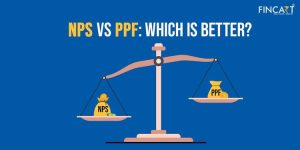Retirement planning isn’t just about saving—it’s about choosing wisely. And when it comes to building a secure future, two names dominate the conversation: the Employees’ Provident Fund (EPF) and the National Pension System (NPS).
Both are government-backed investment options designed for long-term financial security. They differ in terms of returns, taxation, risk level, liquidity, and structure, making them suitable for different types of investors and goals. These schemes are especially relevant for individuals who want to create a stable and growing retirement fund with dependable tax-saving opportunities.
So, which one aligns better with your retirement goals?
In this blog, we break down EPF vs NPS—comparing returns, tax benefits, risks, and flexibility—to help you make a smart, future-ready choice.
What is EPF?
The Employees’ Provident Fund (EPF) is a mandatory retirement savings scheme designed for salaried individuals employed in organizations registered under the Employees’ Provident Fund Organisation (EPFO).
Under this scheme, both the employee and the employer contribute 12% of the employee’s basic salary and dearness allowance each month. EPF is known for offering stable, fixed returns and carries low investment risk, making it a preferred choice for conservative investors.
Here are some of the key features that make EPF an essential part of retirement planning:
- EPF interest rate (2024–25): Approximately 8.25%, revised annually by the government
- Tax benefits: Contributions qualify for deduction under Section 80C
- EEE status: Contributions, interest earned, and withdrawals (after 5 years) are entirely tax-exempt
- Low risk: A fixed income instrument, fully backed by the Government of India
- Liquidity: Allows partial withdrawals for specific life events such as education, home purchase, marriage, or medical emergencies
Overall, EPF serves as a safe and disciplined way to build a long-term retirement corpus, ensuring both stability and tax efficiency.
What is NPS?
TThe National Pension System (NPS) is a voluntary, government-backed retirement investment scheme that allows individuals to build a retirement corpus through market-linked instruments. Regulated by the Pension Fund Regulatory and Development Authority (PFRDA), the NPS is open to all Indian citizens, including salaried professionals, self-employed individuals, and even NRIs.
NPS invests your contributions in a diversified portfolio that includes equity, corporate bonds, and government securities. The returns are not fixed, but have historically ranged between 8% and 11% annually, making it an appealing choice for long-term wealth creation.
Key Features of NPS:
- Tier Structure:
- Tier I: Mandatory account for retirement savings; locked in until age 60.
- Tier II: Optional account with no lock-in, functioning like a regular investment account.
- Tier I: Mandatory account for retirement savings; locked in until age 60.
- Tax-saving investments:
- Deduction of up to ₹1.5 lakh under Section 80C
- Additional ₹50,000 under Section 80CCD(1B)—an extra tax-saving opportunity beyond 80C
- Deduction of up to ₹1.5 lakh under Section 80C
- Customisation & Control:
Choose your own fund manager and asset allocation based on your risk profile and financial goals. - Maturity Rules:
At age 60, you can withdraw up to 60% of the corpus (only 40% is tax-free), while the remaining 40% must be used to purchase an annuity, which provides a monthly pension.
Overall, the NPS scheme offers a flexible and growth-oriented approach to retirement planning, ideal for those comfortable with moderate market exposure and looking to maximize both returns and tax benefits.
EPF vs NPS: Feature-by-Feature Comparison
| Feature | EPF | NPS |
| Nature | Fixed return, debt-based | Market-linked, mixed asset (E/C/G) |
| Interest/Return | ~8.25% (fixed) | 8–11% (variable) |
| Risk | Very low | Moderate (based on asset allocation) |
| Tax Benefits | Section 80C (up to ₹1.5 lakh) | Section 80C + 80CCD(1B) (total ₹2 lakh) |
| Liquidity | Partial withdrawals allowed | Conditional withdrawals after 3 years |
| Lock-in | Until retirement/resignation | Until age 60 |
| Maturity Taxation | Fully tax-free (EEE) | 60% withdrawal allowed (40% tax-free) |
| Annuity Requirement | None | 40% mandatory annuity purchase |
| Fund Control | No control over investments | Choose asset allocation & fund manager |
EPF vs NPS: Which Offers Better Returns?
To compare EPF and NPS meaningfully, let’s consider a real-life scenario that reflects long-term investment growth and retirement benefits.
Scenario:
- Age: 30 years
- Monthly Contribution: ₹6,000
- Annual Increase in Contribution: 10%
- Investment Horizon: 30 years
EPF Calculation:
Assuming a fixed return of 8.25%, the total accumulated corpus over 30 years would be approximately ₹2.1 crore.
- The entire corpus is tax-free
- 100% of the amount can be withdrawn at retirement
- Offers complete liquidity and control over how you use the funds post-retirement
NPS Calculation:
With a market-linked return of 10.5%, the projected corpus would grow to about ₹2.7 crore.
Here’s how it breaks down:
- 60% (₹1.62 crore) is withdrawable as a lump sum at retirement
- 40% (₹1.08 crore) must be used to buy an annuity, which typically yields around 6% annually
- That annuity translates into a monthly pension of around ₹54,000
Verdict:
While NPS beats EPF in nominal corpus, the actual liquidity at retirement (i.e., how much money you can use immediately) may be lower due to taxation and annuity lock-in. EPF, with its full tax-free withdrawal, provides greater control over post-retirement investments.
Tax Saving Angle: Who Wins?
When it comes to tax-saving investments, the National Pension System (NPS) offers a slight advantage over the Employees’ Provident Fund (EPF), especially for high-income individuals.
Here’s how the two compare:
- EPF:
- Eligible for deduction up to ₹1.5 lakh under Section 80C
- Eligible for deduction up to ₹1.5 lakh under Section 80C
- NPS:
- Also allows ₹1.5 lakh deduction under Section 80C
- Plus an additional ₹50,000 under Section 80CCD(1B)
- Also allows ₹1.5 lakh deduction under Section 80C
This extra ₹50,000 deduction can be a game-changer for those in the 30% tax bracket, leading to additional tax savings of up to ₹15,600.
So, if your primary goal is maximising tax benefits, NPS edges ahead with its broader deduction window.
Retirement Planning Strategy: Should You Switch from EPF to NPS?
Switching completely from EPF to NPS isn’t advisable for most individuals. A balanced strategy works better for long-term wealth creation and tax efficiency.
Ideal for Conservative Investors
Stick with EPF if you:
- Prefer low-risk, fixed returns
- Want tax-free withdrawals at retirement
- Value complete control over your retirement corpus
Ideal for Growth-Oriented Investors
Choose NPS if you:
- Are comfortable with market fluctuations
- Aim for higher long-term returns
- Seek additional tax deductions beyond Section 80C
Ideal Retirement Planning Mix
A smart retirement planning strategy often combines both. Use EPF as your stable foundation and complement it with NPS to enhance growth potential and tax savings. This diversified approach balances safety and growth—something every wise retirement planner aims for.
Final Thoughts: EPF vs NPS — Which is Right for You?
There’s no one-size-fits-all answer to the EPF vs NPS debate. Your choice should depend on:
- Risk appetite
- Investment horizon
- Tax planning needs
- Post-retirement goals
If capital safety and liquidity are important, EPF is more suitable. If you’re looking for higher returns and added tax deductions, NPS can complement your retirement planning.
Pro tip from Fincart: Don’t put all your retirement eggs in one basket. Diversify. A combination of EPF, NPS, and other tools like PPF or mutual funds can give you the right balance of security, growth, and flexibility—just like a professional retirement planner would recommend.
FAQ’s
Q1: Can I have both EPF and NPS?
Yes, you can invest in both EPF and NPS to build a diversified retirement corpus with the benefits of stable returns and market-linked growth.
Q2: Is it good to transfer EPF to NPS?
It’s allowed, but not always ideal. EPF offers fixed, tax-free returns, while NPS is market-linked. Transfer only if you’re comfortable with market risk.
Q3: Is EPF good for retirement?
Yes, EPF is a safe, tax-efficient, and reliable retirement option with guaranteed returns and long-term wealth creation through compounding.




